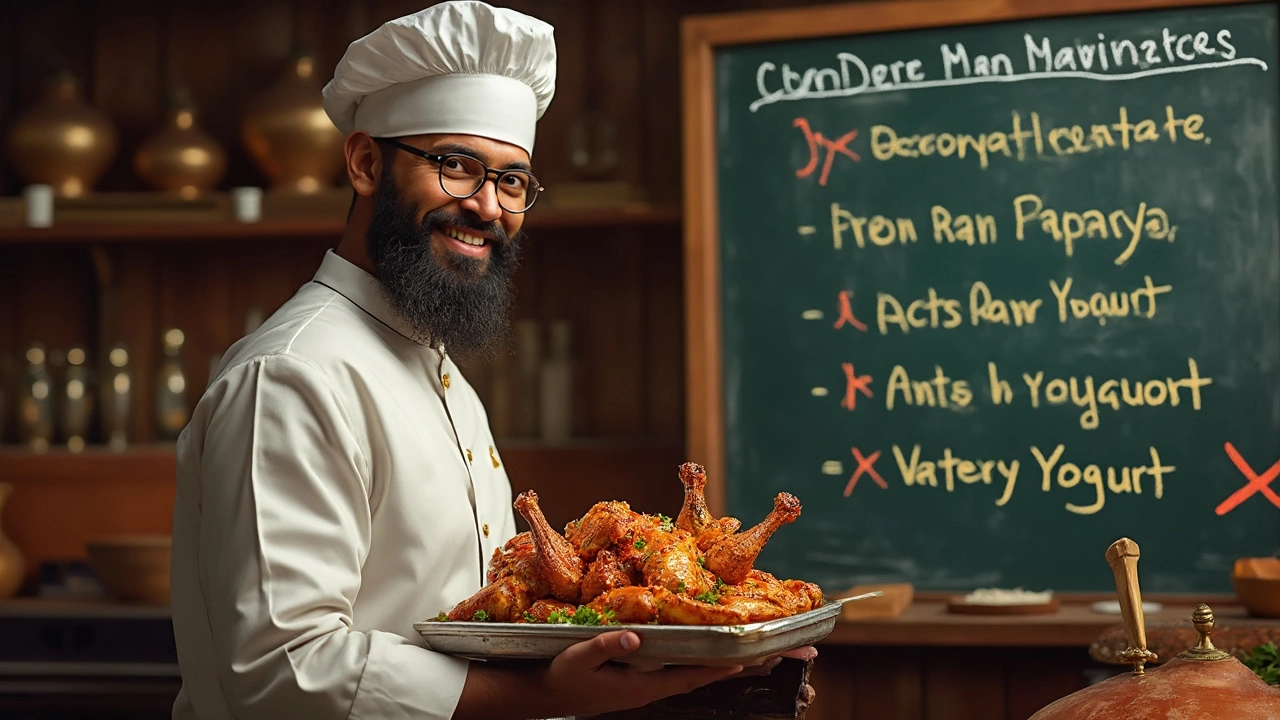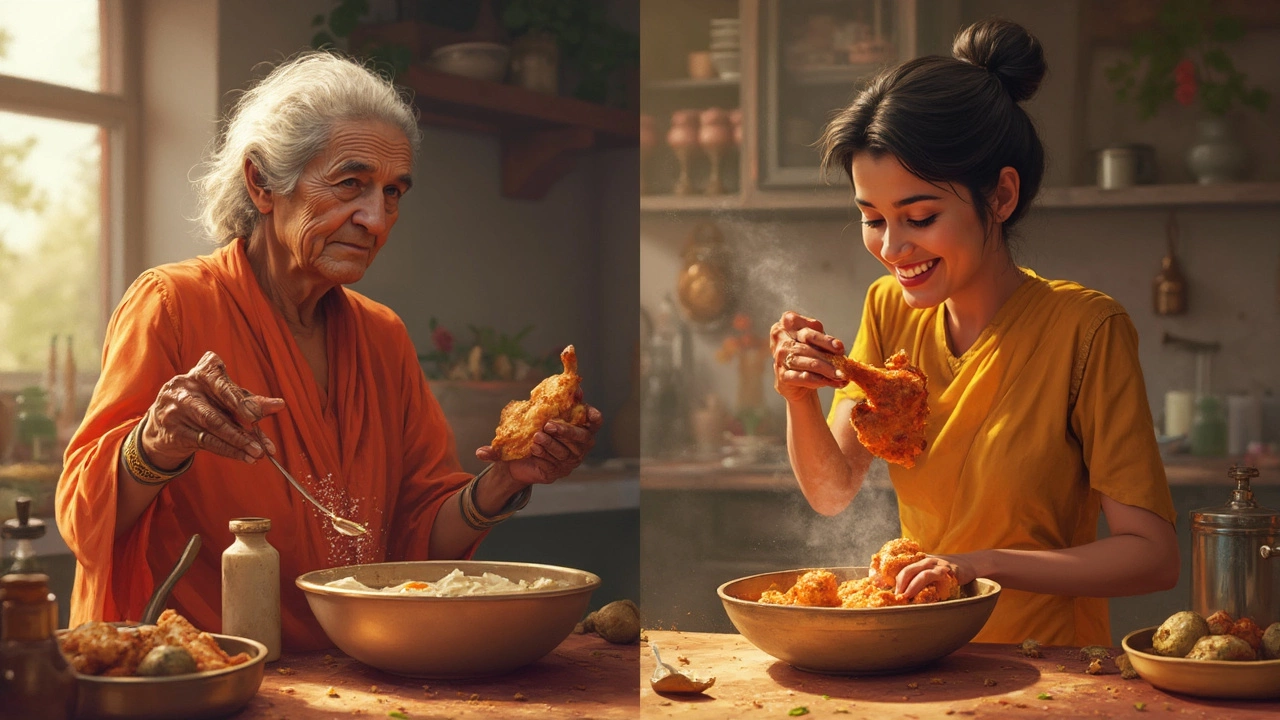Ever wonder why your tandoori chicken sometimes feels weirdly mushy or barely tastes like anything? The problem could be hiding in your marinade. Not every kitchen staple belongs in the bowl—some things can wreck your chicken’s texture or totally wipe out those signature tandoori flavors.
It’s easy to think, “If a little of this is good, a lot must be great!” But honestly, that’s how you end up with gray, rubbery chicken that nobody wants to eat. Certain ingredients—like too much raw papaya or pineapple—will break down the meat until it’s almost falling apart before it even hits the grill. Other things, like heavy oils or bold sauces, can cover up all the zingy spices you worked so hard to mix in.
Let’s talk about what not to put in your marinade if you want juicy, aromatic, and truly tandoori chicken. Ready to rescue dinner?
- Why Some Ingredients Backfire
- Avoid These Common Marinade Add-Ins
- The Case Against Acid Overload
- Too Much Salt: Tender or Tough?
- Pro Tips for Killer Tandoori Marinades
Why Some Ingredients Backfire
Ever had chicken that felt slippery, tasted flat, or just didn’t hold the spices? That’s usually from using the wrong stuff in your marinade. Marinating isn’t only about flavor—it changes how the chicken holds up when it cooks. Some ingredients start breaking down the proteins or pulling out moisture in a way that makes the meat feel tough, stringy, or too soft.
Here’s what’s going on: acids (like lemon juice or vinegar) and enzymes (from fruits like pineapple or papaya) can start dissolving the chicken’s structure if used in the wrong amounts or left too long. You want the meat to get juicy and pick up the spices, but you don’t want it turning into mush or losing that satisfying chew.
Let’s break down the troublemakers commonly found in tandoori chicken marinades:
- Enzyme-heavy fruits: A little papaya or pineapple can tenderize, but too much turns the meat to sludge. Papain (from papaya) is so strong that just 30 minutes in a heavy papaya marinade can totally change the meat’s texture.
- Too much acid: Lemon juice and vinegar are awesome for flavor, but they start "cooking" the chicken if you soak for hours, leaving weird, almost mealy bits on the outside.
- Oils and heavy yogurts: A bit of oil or thick yogurt helps coat the chicken with spices, but too much creates a greasy barrier. That stops spice flavors from soaking in and makes grilling tricky.
- Extra salty sauces: If you’re using soy or a lot of salt, know that it can actually pull water out of the meat, making it dry even before it goes on the fire.
If you want proof, look at what food scientists say. Marinating too long in an acidic or enzyme-heavy mixture can change meat texture in as little as 1-3 hours, especially with thin chicken pieces.
| Ingredient | Common Effect When Overused | Safe Melting Time |
|---|---|---|
| Papaya (raw) | Over-tenderizes, mushy texture | 15-30 minutes |
| Pineapple (fresh) | Stringy, watery | 20-40 minutes |
| Lemon juice | Tough/mealy outside | 1-2 hours |
| Plain yogurt | Good for flavor; too much breaks down protein | 4-6 hours |
| Soy sauce | Dries out chicken | 1-2 hours |
Stick to balanced doses and watch your timing—your tandoori marinade isn’t just about throwing everything in the bowl. Next, let’s look closer at the usual suspects that cause the most chaos in your cooking.
Avoid These Common Marinade Add-Ins
It’s so tempting to toss in anything that promises more flavor or faster tenderizing, but a classic tandoori chicken marinade works best when you steer clear of a few usual suspects. Here’s what you should actually leave out and why.
- Enzyme-heavy fruits: Raw pineapple, papaya, and kiwi get hyped for tenderizing meat because they carry enzymes (bromelain and papain). Too much, though, and your chicken turns mushy. For tandoori, stick to lemon juice or yogurt for gentle tenderizing.
- Vinegar or strong acids: While a splash of lemon is perfect, dumping in lots of vinegar or sour juices will toughen up your chicken and hide delicate spices. A little is good; a lot is trouble.
- Excessive salt: Too much salt pulls moisture from the meat, making it dry instead of juicy after grilling. Use less than you might for an American-style brine—Indian marinades get plenty of zip from the spices.
- Oily sauces: Heavy mayo, salad dressings, or sesame oil smother the spices, blocking that mouthwatering char. Tandoori needs just enough oil to help spices stick; go easy on the drizzle.
- Store-bought barbecue or sweet sauces: These caramelize too fast and often burn in a hot tandoor or on the grill, leaving a bitter aftertaste. You want to taste the bright spices, not fake smoke flavor.
- Artificial tenderizers: That meat tenderizer powder at the back of your spice rack? Skip it. It’s too strong for chicken, and if you’re using yogurt, you truly don’t need it.
Check out how some of these extras actually impact your tandoori marinade:
| Ingredient | What It Does | What Really Happens |
|---|---|---|
| Pineapple Juice | Breaks down protein | Makes chicken mushy if left over 30 min |
| Vinegar (over 1 tbsp) | Adds tang | Masks spices, can make meat tough |
| BBQ Sauce | Adds smoky flavor | Overpowers classic tandoori taste, burns quickly |
| Heavy Oil (over 2 tbsp) | Makes marinade richer | Prevents even char, dulls spice flavors |
If you’re looking to play around, try giving new spices a shot instead of risky liquids or store-bought blends. Keep things simple and let those classic tandoori flavors shine through.

The Case Against Acid Overload
Splashing in lemon juice, yogurt, or vinegar is a go-to move in almost every tandoori chicken marinade. But more isn’t always better. If you drown the chicken in acidic stuff, it can actually wreck the texture instead of making it deliciously tender.
Here’s what really happens: acid breaks down protein in the meat. A short bath in a little yogurt or lemon adds flavor and softens things up, but soaking for hours (or dumping in extra acid "just to be sure") will turn those proteins mushy and chalky. Nobody wants chicken that bites back—or worse, falls apart in a sad, wet pile. The scientists at America’s Test Kitchen found that marinating chicken in lemon juice for over 2 hours actually led to "a soft and unpleasant mouthfeel."
"You’d be surprised—marinades packed with acid don’t make meat more tender. They just make it mushy. Limit acid time and quantity to protect texture and flavor."
– Cook’s Illustrated Kitchen Testers
To put it in perspective, check out what happens after different soaking times with tangy marinades:
| Acid Type | Soak Time | Texture Result |
|---|---|---|
| Lemon juice | 30 min | Moist, tender |
| Lemon juice | 2 hrs | Edges mushy, center dry |
| Yogurt | 6 hrs | Balanced, slightly tangy |
| Vinegar | Overnight | Stringy, tough |
So, how much acid is just right? For tandoori chicken, keep lemon juice or vinegar minimal—about 1–2 tablespoons per pound of chicken—and don’t marinate longer than 3-6 hours if you want the best bite. For yogurt-based marinades, 4-8 hours is the sweet spot—overnight is okay, but skip the "all day" soaks with just lemon or vinegar.
Bottom line: low acid plus shorter marinating time lets spices shine, and keeps chicken juicy and firm. Go easy and your tandoori will turn out just right every time.
Too Much Salt: Tender or Tough?
If you think extra salt in your chicken marinade means more flavor, it’s not that simple. Salt changes chicken in a big way—it doesn’t just season, it actually draws water out of the meat through osmosis. When you overdo the salt, you can end up with dry, chewy tandoori chicken, especially if you leave it in the marinade too long.
In tandoori chicken recipes, the goal is juicy, flavorful meat with soft, almost charred edges, not something that feels like jerky. So, how much is too much? A solid guide is about 1 teaspoon of salt per pound of chicken in the marinade. Anything more, and the chicken starts to dehydrate or even break down the muscle fibers too far.
Check this out:
| Salt Amount | Marinating Time (max) | Texture Outcome |
|---|---|---|
| 1/2 tsp/lb | Up to 24 hrs | Mild, slightly tender |
| 1 tsp/lb | 6-12 hrs | Juicy and seasoned |
| 2 tsp/lb+ | Over 6 hrs | Can get stringy or tough |
Another problem? If your marinade already includes salty yogurt or spice pastes, the sodium sneaks up on you fast. Always taste the marinade—just a drop before adding in the chicken. If it tastes a bit too salty, thin it with a splash of plain yogurt or lemon juice. Also, avoid salty bottled sauces or additional seasoning cubes; you don’t want your tandoori to taste like a salt lick.
If you accidentally make your marinade too salty, rinse the chicken quickly before cooking. It won’t fix everything, but it’ll help cut down the sharpness. The point is: salt is powerful, but more isn’t always better. Better to err on the side of less—you can sprinkle a bit more after grilling if you need that little extra boost.

Pro Tips for Killer Tandoori Marinades
If you want your tandoori chicken to hit that sweet spot—juicy inside, charred outside, and packed with bold flavors—marinade technique is everything. Here’s what works every single time:
- Balance your acid. Yogurt is classic for tandoori, but don’t drown the chicken in lemon juice as it can turn the meat mushy. Stick to 1-2 tablespoons lemon or lime juice per 500g chicken.
- Spice ratios matter. Ground coriander, cumin, chili powder, turmeric, and garam masala are your go-tos. Fresh ginger and garlic pack in aroma. Too much clove, cinnamon, or nutmeg can taste medicinal; use sparingly.
- Oil is a must, but don’t go overboard. Just enough oil (about 2 tablespoons per 500g chicken) helps bind spices and gets you that signature tandoori char.
- Salt with care. Salt is important, but don’t saturate your marinade—about 3/4–1 teaspoon per 500g chicken does the trick.
- Avoid store-bought sauces. Ketchup, mayonnaise, and barbecue sauce drown out the tandoori flavor and make the texture weird. Go for simple, fresh, and bold ingredients.
- Marinate long enough—but not forever. 6–8 hours in the fridge is the gold standard. More than 24 hours and your chicken can get unpleasantly soft.
Check out this quick table for the perfect tandoori marinade ratios (for 500g chicken):
| Ingredient | Amount | Purpose |
|---|---|---|
| Plain Yogurt | 1/2 cup | Tenderizes & adds creaminess |
| Lemon Juice | 1-2 tbsp | Adds tang (don’t overuse) |
| Oil | 2 tbsp | Helps spices bind & chars skin |
| Garlic (fresh grated) | 2 tsp | Aroma & flavor |
| Ginger (fresh grated) | 2 tsp | Aroma & flavor |
| Salt | 3/4–1 tsp | Enhances flavor |
| Spice Mix | 2–3 tsp | Signature tandoori chicken flavor |
For best results, always use non-reactive bowls (like glass or plastic), never metal. Cover the chicken and let it chill in the fridge, not on the counter. Finally, pat the chicken dry before cooking if you want crisp, charred edges—damp chicken doesn’t brown well!
